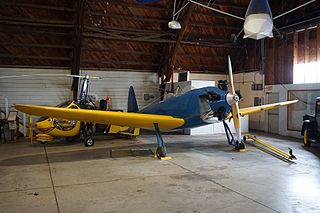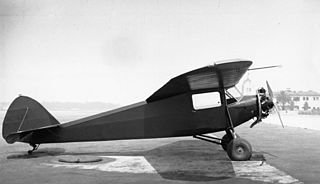
The Curtiss Robin, introduced in 1928, is an American high-wing monoplane built by the Curtiss-Robertson Airplane Manufacturing Company. The J-1 version was flown by Wrongway Corrigan who crossed the Atlantic after being refused permission to do so.

The Monocoupe 90 was a two-seat, light cabin airplane built by Donald A. Luscombe for Monocoupe Aircraft. The first Monocoupe was built in an abandoned church in Davenport, Iowa, and first flew on April 1, 1927. Various models were in production until the late 1940s.

The Warner Scarab is an American seven-cylinder radial aircraft engine, that was manufactured by the Warner Aircraft Corporation of Detroit, Michigan in 1928 through to the early 1940s. In military service the engine was designated R-420.

The Cessna Airmaster, is a family of single-engined aircraft manufactured by the Cessna Aircraft Company. The Airmaster played an important role in the revitalization of Cessna in the 1930s after the crash of the aviation industry during the Great Depression.

The Aeronca L is a 1930s American cabin monoplane designed and built, in small numbers, by Aeronca Aircraft. It differed significantly from other Aeronca planes by the use of radial engines, streamlining, and a cantilever low wing.
The Warner Scarab Junior was an American, five-cylinder, air-cooled, radial aero engine first produced in 1930. It was a scaled-down derivative of the seven-cylinder Warner Scarab, developing 90 hp (70 kW) against the Scarab's 110 hp (80 kW).

The Culver Cadet is an American two-seat light monoplane aircraft, also as a radio-controlled drone, produced by the Culver Aircraft Company.

The Cessna Model A is a 1920s American high-wing four-seat tourer built by the Cessna Aircraft Company, the first in a long line of high-wing single-engined monoplanes.

The Kreider-Reisner Challenger is an American utility biplane aircraft designed and produced by the Kreider-Reisner Aircraft Company, which was later taken over by the Fairchild Aircraft Company.

The Fairchild 22 Model C7 was an American two-seat touring or training monoplane designed and built by the Kreider-Reisner division of the Fairchild Aircraft Corporation at Hagerstown, Maryland.

The Ryan S-C (Sports-Coupe) was an American three-seat cabin monoplane designed and built by the Ryan Aeronautical Company. At least one was impressed into service with the United States Army Air Forces as the L-10.

The Rearwin Sportster is a 1930s American two-seat, high-winged, cabin monoplane designed and built by Rearwin Aircraft & Engines for sport/touring use.

The Stinson Junior was a high-winged American monoplane of the late 1920s, built for private owners, and was one of the first such designs to feature a fully enclosed cabin.

The Waco A series is a range of light American-built twin side-by-side seater sporting biplanes of the early 1930s.
The Curtiss-Wright CW-3 Duckling was an American two-seat amphibian flying-boat developed by Curtiss-Wright from the CW-1 Junior.

The Mohawk M1C was a 1920s American two or three-seat low-wing monoplane designed and built by Mohawk Aero Corporation of Minneapolis, Minnesota. One M1C was evaluated by the United States Army Air Corps in 1930 as the YPT-7 Pinto for use as a primary trainer.

The Pasped W-1 Skylark is a 1930s American two-seat single-engined cabin monoplane designed and built by the Pasped Aircraft Company of Glendale, California.

The Davis D-1 is an American light two-seat parasol-winged monoplane of the late 1920s.

The Howard DGA-18 was an American two-seat basic training aircraft designed and built by the Howard Aircraft Corporation for the United States Civil Pilot Training Program.

The Kari-Keen 90 Sioux coupe is a two-seat cabin monoplane.




















